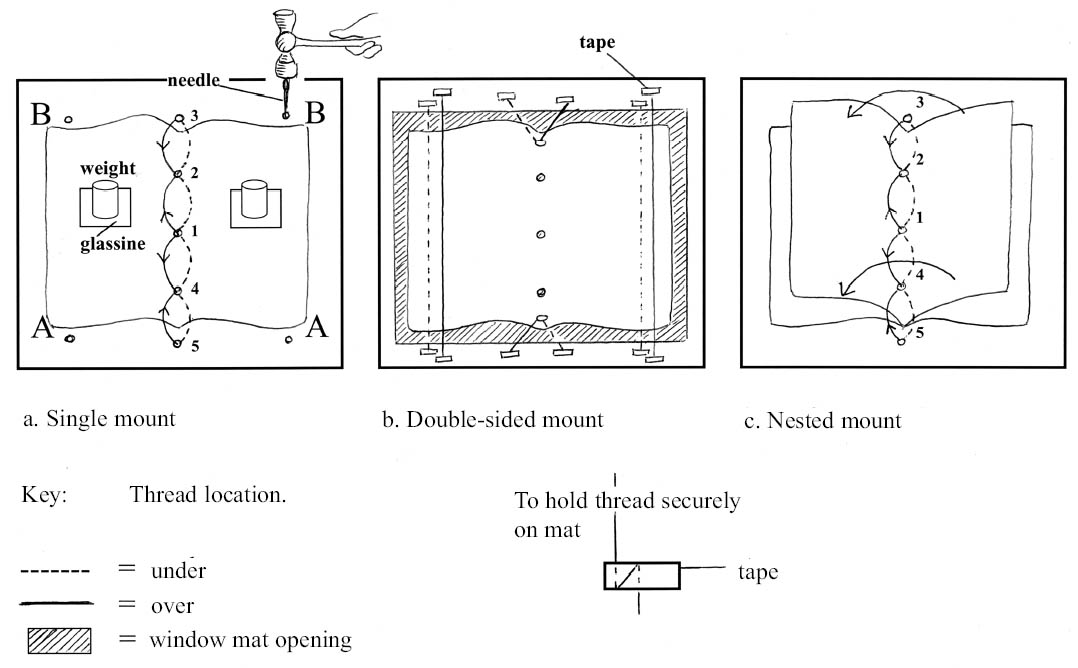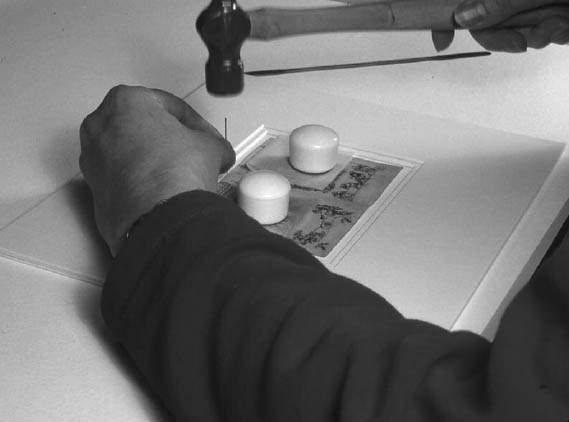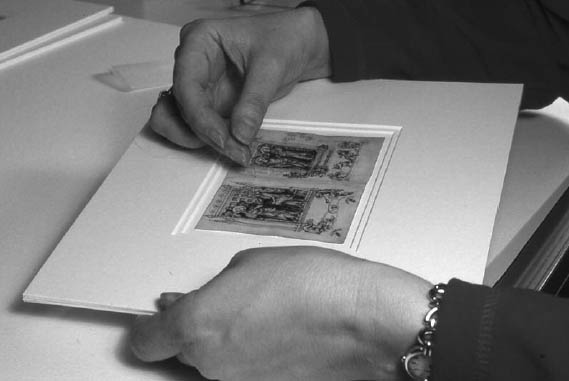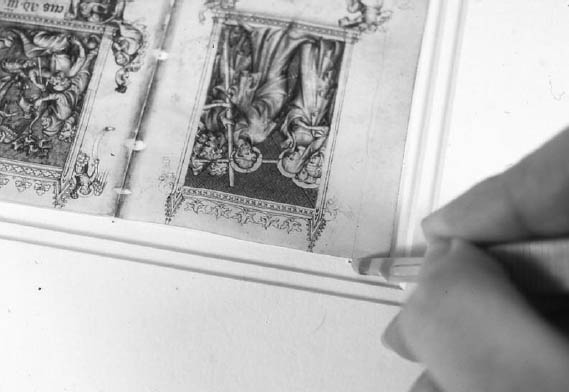A METHOD OF MOUNTING PARCHMENT USING HAIR SILKMARGARET LAWSON
ABSTRACT—A straightforward, secure, nonadhesive method of mounting parchment using hair silk was devised for the exhibition of Jean Pucelle's manuscript, The Hours of Jeanne d'Evreux, from the Cloisters Collection of the Metropolitan Museum of Art, New York. Adhesive attachments were not acceptable because the selected folios, which were to be rebound, had no former adhesive attachment, the margins needed to remain pristine for rebinding, and any application or removal of adhesive would disturb the vellum. The requirements of the mounting method were to be able to safely support the leaves in travel and exhibition without abrading pigmented media and to be unobtrusive so as not to obscure or detract from the incredibly fine design elements. The materials, experimental methods, and testing that led to the development of the hair silk mounting system, as well as the three exhibition formats, are described. Additional suggestions, adaptations, and limitations of the system are discussed, and sources for materials are provided. TITRE—Une m�thode de montage pour les parchemins utilisant des fils de soie. R�SUM�—Une m�thode de montage pour les parchemins, simple, s�re, sans colle et utilisant des fils de soie, a �t� con�ue pour l'exposition du manuscrit de Jeanne Pucelle, Les heures de Jeanne d'�vreux, de la collection des Clo�tres au Metropolitan Museum of Art (mus�e m�tropolitain d'art) � New York. L'emploi de colle pour le montage n'�tait pas acceptable car les folios choisis, qui devaient �tre r�int�gr�s dans la reliure, ne pr�sentaient aucun vestige de colle. Les marges devaient aussi rester en parfait �tat pour le remontage, et toute application d'une colle ou son retrait risquait d'affecter le v�lin. Le montage devait non seulement pouvoir soutenir ad�quatement les feuilles durant le transport et l'exposition sans abraser les surfaces pigment�es, mais aussi �tre discret pour ne pas obscurcir ou amoindrir les �l�ments incroyablement fins du dessin. Les mat�riaux, les m�thodes exp�rimentales et les essais qui ont men� au d�veloppement du syst�me de montage avec des fils de soie sont d�crits, ainsi que les trois formats d'exposition. Des suggestions suppl�mentaires, des adaptations, et les limitations du syst�me sont pr�sent�es, et les adresses o� se procurer les mat�riaux sont fournies. TITULO—Un m�todo para montar pergamino utilizando filamentos de seda. RESUMEN—Se dise�� un m�todo simple, seguro y no adhesivo para montar pergamino utilizando filamentos de seda, para la exhibici�n del manuscrito de Jeanne Pucelle “Las horas de Jeanne d'Evreux,” perteneciente a la colecci�n de los Claustros del Metropolitan Museum of Art (Museo Metropolitano de Arte) de Nueva York. No era aceptable asegurarlos por medios adhesivos ya que los folios seleccionados, que iban a ser encuadernados, no hab�an sido adheridos nunca y los m�rgenes ten�an que permanecer intactos para ser encuadernados. Cualquier aplicaci�n o remoci�n de adhesivo hubiera producido da�o en el pergamino. Era indispensable que el m�todo seleccionado para el montaje ofreciera suficiente soporte a las hojas durante el transporte y la exhibici�n sin que se produjera abrasi�n en el medio pigmentado y que fuera casi invisible para no obscurecer ni impedir la visibilidad de los dise�os incre�blemente finos. Se describen los materiales, m�todos experimentales y pruebas efectuadas que condujeron al desarrollo del sistema de montaje con filamento de seda y tres formatos de exhibici�n. Tambi�n se describen sugerencias adicionales, adaptaciones y las limitaciones que tiene el sistema y se indican las fuentes para la consecuci�n de los materiales. T�TULO—Um m�todo de montagem de pergaminho usando fios de seda. RESUMO—Um m�todo simples, seguro e sem adesivo para montagem de pergaminhos usando fios de seda foi idealizado para a exposi��o do manuscrito de Jeanne Pucelle, The Hours of Jeanne d'Evreux, pertencente � cole��o Cloisters do Metropolitan Museum of Art (Museu Metropolitanod de Arte) de Nova Iorque. Fixa��es com adesivos n�o eram aceit�veis uma vez 1 INTRODUCTIONJean Pucelle's manuscript, The Hours of Jeanne d'Evreux (1320s) from the Cloisters Collection of the Metropolitan Museum of Art, New York, presented a welcome challenge when it was decided to mount more than 40 conserved leaves in a variety of formats for the exhibition Prayerbook for a Queen: The Hours of Jeanne d'Evreux, for loan to the J. Paul Getty Museum and display at the Metropolitan Museum of Art. Commissioned by Charles IV, this treasured prayer book was a most precious gift for his cousin, bride, and queen, Jeanne d'Evreux. The tempera and ink on vellum manuscript, disbound for conservation and facsimile photography, is exceedingly small (page size 6.2 � 8.9 cm [31/2 in. � 27/16 in.]). Composed of more than 200 folios, the manuscript includes 25 extraordinarily fine full-page miniature paintings in both color and grisaille and abundant, wonderfully fluid and facile depictions of all kinds of characters, animals, and life in the marginalia of the text and painted pages. The spine folds of the leaves had been flattened during conservation treatment, and the pages were planar for matting. 2 OBJECTIVESAny method of securing the leaves that would cover the marginalia or illuminations was undesirable because of the extremely fine drawings and details. In addition to the appearance, it was important to consider the highly reactive nature of the very thin vellum, which would be disturbed by the application and removal of adhesives. As the essence of conservation is preservation, it was imperative that the margins of the bifolios not be altered by any attachment or inlay process, but that they remain untouched as they were to be rebound. Objects that cannot be hinged are often mounted with corners attached to a backboard and then overmatted to hold them in place. However, when Jeanne d'Evreux manuscript pages were overmatted, the pages looked cramped, and there was the added concern that even if the mat board window was sanded on the inside bevel, the mat contact edge might abrade covered design areas. Another consideration was that the objects and mounts had to withstand vibrations in travel and—as the show opened at the J. Paul Getty Museum—possibly earthquakes. A number of materials and techniques for nonadhesive attachment were experimented with during the decision-making process. Most involved fashioning supportive corners or narrow “straps” that held the sheet to the back mat or window mat, and all allowed the sheets to be floated in the window mat, but objections were found to all of them. Straps made with threads of twisted silk, cotton, or linen were too thick and distracting. “Invisible” nylon thread was possibly too hard and strong. Under stress, it is desirable to have the form of attachment give way rather than causing fractures, cuts, tears, or imprints in the art. The nylon thread did not give or break easily and might cut the vellum when tightened or tensed. The thread also became visible under gallery lights and created shadows on the art. Crepeline (silk gauze) corners or straps tended to fray with any manipulation after cutting. Introducing a stabilizing material to the edges might have made them sharper and abrasive. Stabiltex, a plain woven multifilament polyester fabric by Swiss Silk Bolting Cloth Manufacturing Company, Zurich, was also too visible After experimenting with numerous materials and methods of securing the objects, a solution was reached using strands of hair silk. Hair silk is the term given to the filament of the silk as it comes out of the cocoon. It proved to be visually acceptable (almost invisible), soft enough so it would not cause abrasion of pigments or cut the vellum, and strong enough to support the objects in presentation. Hair silk was used to mount the Jeanne d'Evreux leaves in the three different matting formats as pictured in figure 1: figure 1a as single leaves, figure 1b floating in a double-sided mat, and figure 1c in a nested arrangement in which one bifolio is positioned on top of another bifolio, with the uppermost page turned over to one side so that two facing pages can be seen as they would appear face-to-face in the manuscript. (A bifolio is one piece of vellum, folded in half, which forms two leaves or four pages front and back.) 3 HAIR SILK (SILK THREAD)Commonly known to textile conservators, hair silk is a very fine proteinaceous filament obtained from cocoons of silkworms. Hair silk is sold in a skein (fig. 2). To prevent tangles and numerous short ends over time, the skein keeps better if it is cut in one place and made into a long braid from which one strand can be easily pulled at a time (fig. 3). Cutting to create the braid might be problematic only if very long threads were required for a project. To test the suitability of hair silk as a mounting material, a mock-up of the inner frame package for a single bifolio was created. A piece of repair parchment, as similar to the manuscript vellum as it was possible to find, was mounted with hair silk in a double step mat. This mat was placed on top of a piece of conditioned Art-Sorb silica gel sheet material, a moisture-sensitive silica material composed of amorphous silica blended with small amounts of hygroscopic salts from Fuji Silysia Chemical, with
This mock-up was wrapped in bubble wrap and shipped in a Federal Express box to the J. Paul Getty Museum. It arrived safely. After consultation, the Getty staff returned it in the same manner. As an additional test, the box with the mock-up was intentionally dropped a few times. No changes were noted upon opening the unit on return. The framing system described above does not relate to the double-sided mounts, as these mounts were designed for installation on-site. Hair silk proved to be visually acceptable. It was almost invisible, soft enough so that it would not abrade design materials or cut the vellum, and strong enough to support the objects in presentation. 4 MATERIALSMaterials needed to accomplish the hair silk mounting procedure include a sewing needle with a strong but small eye, a small soft-headed hammer, linen tape, a burnisher, a pin vise (tiny hand drill, fig. 4), a light box, a loop, a small scalpel, and hair silk (available from Talas in two- and four-strand skeins). (We used double stranded.) 5 METHODS OF MOUNTING5.1 SINGLE MOUNTSSingle mounts are used to exhibit a single bifolio. The bifolio is stitched through the pre-existing sewing holes along the spine fold to the four-ply rag backboard. A double-step or eight-ply upper window mat provides protection for the floating object, preventing any natural undulations in the page from touching the Plexiglas. Please refer to figure 1a, Single mount (left diagram), throughout the following description.
5.2 DOUBLE-SIDED MOUNTSDouble-sided-mounts permit a bifolio to be centered and floating inside a double-sided window mat. The rag board on each side is eight-ply, with one side designated as the back mat. A series of carefully angled hair silk loops originating from the midtop and
Please refer to figure 1b, Double-sided mount (center diagram), throughout the following description.
5.3 NESTED MOUNTSNested mounts allow two separate bifolios to be shown together as they would appear in the book. Nested mounts use the same basic mat as the single mounts, but two bifolios are stitched together, through pre-existing sewing holes along the spine fold, to the backboard. The top bifolio is folded over to show the appropriate facing page, and holes are drilled in the backboard for the side straps that pass over the outer edges of the leaves. One strap passes over the single side of one-half of the bottom bifolio, and the other strap covers the folded-over upper bifolio plus the other half of the bottom page (fig. 9). Please refer to figure 1c, Nested mount (right diagram), throughout the following description.
6 ADAPTATIONS AND LIMITATIONSThe approach outlined was devised for the safe and aesthetically pleasing display of the very small, precious vellum leaves from the 14th-century manuscript, The Hours of Jeanne d'Evreux. Since then, hair silk mounts have been used for special exhibitions and loans of larger bifolios, including those from The Belles Heures of Jean of France, Duke of Berry manuscript by the Limbourg brothers. Some of the bifolios have been framed in mats as described in the single mount section. Some of the leaves were mounted to four-ply rag board supports with narrow margins and without window mats. These were installed hanging vertically or on angled decks inside exhibition cases at the Cloisters. Scrolls (relaxed and flattened) have been considered for mounting with hair silk straps. One narrow scroll about 1.5 meters long was effectively mounted vertically, hanging in a frame, using a combination of hair silk straps and stitching, but another was found to be too heavy, distorted, and fragile. Small paperboard cards and irregular parchment cuttings have been displayed using diagonally stitched corners and/or straps of hair silk. Multiple-piece objects—works such as triptychs, diptychs, or unusual assemblages with elements that need to be united and secured without adhesive may also be easily shown together, even if only for temporary exhibition.
Hair silk has been utilized for mounting leather artifacts. Smaller or lightweight three-dimensional objects and ethnographic materials might also be good candidates. By design, double-sided mounts are non-load-bearing, and therefore larger, heavy, or brittle parchment objects would not lend themselves to such gentle systems in which strands of hair silk hold the vellum leaves without the support of a mat board backing. The double-sided system proved to be very durable for the exhibition of the Jeanne d'Evreux leaves, as the experimental and demonstration model continues to be centered and balanced, and intact, now more than five years without the protection of a case or glazing. However, the double-sided mount with hair silk is not recommended for travel in a frame. The amount of buffering material that can be provided for environmental control in the double-sided frame is limited. For safety, the double-sided mount requires final adjustments and installation onsite. These mounts were specifically designed for installation in freestanding slim cases with drawers for silica gel at the J. Paul Getty Museum. The mount slipped into fabric-covered Plexiglas windows held in place by magnetic bars. Upon return to the Metropolitan Museum of Art, the double-sided mounts were installed in double-sided frames for exhibition in the museum's galleries. 7 CONCLUSIONSSilk is known to last for centuries, but the long-term aging characteristics of the hair silk used in this context have not been determined. Therefore it is not recommended for long-term storage mounts. Yet, for the duration of exhibits, hair silk provides a soft, strong, safe, sensitive, reversible method for display of vellum and parchment leaves. The hair silk has lent itself for mounting use with a variety of shapes and kinds of objects, from very irregular cuttings on parchment, where judiciously placed straps provided a secure system, to a hanging scroll, very small paper items in which corner threads or straps become invisible, leather artifacts, and temporary groupings of materials that need to be held together on a support without adhesive. Experience suggests that a greater range of conservation problems outside of the paper and textile arena could utilize hair silk for mounting, including some three-dimensional and ethnographic objects. As for everything in conservation, needs must be evaluated case by case. Media must be secure, the support must be in good condition, and thoughtful consideration must be given to the positioning of hair silk straps. The flattening of spine folds, creases, or rolled scrolls is necessary, but flattening parchment does not guarantee that it will stay flat. Variables such as weight, thickness, degree of flexibility or brittleness, and whether the object is to be displayed flat or vertically determine if it may or may not be possible to safely support heavy large-format items with hair silk. The purpose of the hair silk is not to control the object or deformations but to permit the parchment to exist comfortably on display, allowing for possible expansion and contraction. This aim explains why mounting holes are drilled slightly away from the edge of the art. Only pre-existing holes in parchment are used for stitching to a support. If there are no holes or not enough holes in larger objects, hair silk straps may not provide adequate support, and some other system may need to be devised. Some of the decision-making process is intuitive. It may be necessary to add extra threads for heavier or larger objects and to consider running a gentle thread strap in a vertical direction to reduce the tendency of the interior portion of pages to pull up toward the Plexiglas in a framed mount. There are many advantages to using passive (nonadhesive) mounting systems. Hair silk is easily reversible, and it can be readily toned. It is not a perfect material for all objects, but it does provide unique advantages for illuminated manuscript leaves and in situations that require works to be held in a nonadhesive, nonintrusive system of display. It is hoped that these findings will encourage others to explore the use of hair silk when it is found to be appropriate, and to utilize and develop alternative passive mounting methods and materials when hair silk and other traditional systems do not best serve the object. ACKNOWLEDGEMENTSMy sincere thanks to many people for their help and suggestions on this project: Barbara Boehm for presenting the challenge, and Marjorie Shelley and colleagues in the Sherman Fairchild Center for Works of Art on Paper and Photograph Conservation: Ann Baldwin, Martin Bansbach, Sarah Bertalan, Mary Jo Carson, Ross Chambers, Lee Ann Daffner, Alison Gilchrest, Akiko Yamazaki-Kleps, Pau Maynes, Rachel Mustalish, and Yana Van Dyke. Special thanks are also due to Metropolitan Museum of Art colleagues: Joe Bamberger, Nancy Britton, Mindell Dubansky, Christine Giuntini, Chris Paulocik, who introduced me to hair silk, and the Department of Textile Conservation. In addition, I am grateful to Karen Crisalli, who very generously supplied the piece of repair parchment for mock-up tests; Abigail Quandt; and J. Paul Getty staff: Thomas Kren, Liz Teviotdale, and Nancy Turner. SOURCES OF MATERIALSPin vise and drill bits: Mascot Precision Tools #H812 pin vise drill set (2 collets) and 6 popular steel drillsFor catalog: Mascot Precision Tools Division of Grobet File Company of America, Inc. 750 Washington Ave. Carlstadt, N.J. 07072 Purchased from: Pearl Paint 308 Canal St. New York, N.Y. 10013 (212) 431-7932. See additional examples in Micro-Mark catalog. Linen tape: Neschen Filmoplast SHNeschen Corporation 2201 Brentwood Rd. Suite 114 Raleigh, N.J. 27604 (919) 876-4198 Fax: (919) 876-9484 Ordered from: United Mfrs. Supplies Inc. 80 Gordon Dr. Syosset, N.Y. 11971 (800) 645-7260 Silk thread (hair silk) 100% silk thread, imported from France, used in textile repair Same thread as that used to weave Crepeline; natural color; 100 gm skeins Available in two-strand and four-strand. (We used two-ply.)Talas 20 W. 20th St. 6th floor New York, N.Y. 10011 (212) 219-0770 Fax: (212) 219-0735 Needles and weights (wonder weights): from a sewing store or:Clotilde P.O. Box 7500 Big Sandy, Tex. 75755 (800) 772-2891 Marvelseal 360, an aluminized nylon and polyethylene barrier filmTalas 20 W. 20th St. 6th floor New York, N.Y. 10011 (212) 219-0770 Fax: (212) 219-0735 J-LAR TapeTalas 20 W. 20th St. 6th floor New York, N.Y. 10011 (212) 219-0770 Fax: (212) 219-0735 AUTHOR INFORMATIONMARGARET LAWSON has been a paper conservator at the Metropolitan Museum of Art in New York since 1981. She has a B.A. in studio art and art history from the College of Wooster, in Wooster, Ohio, and an M.A. and certificate of advanced study from the State University of New York, College at Oneonta, New York (Cooperstown Graduate Program in the Conservation of Historic and Artistic Works). Address: Sherman Fairchild Center for Works on Paper and Photograph Conservation, Metropolitan Museum of Art, 1000 Fifth Ave., New York, N.Y. 10028
 Section Index Section Index |





